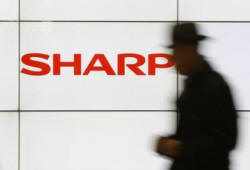|
 Japan
tech strategy shifts see Sharp skid as Panasonic
prospers Japan
tech strategy shifts see Sharp skid as Panasonic
prospers
 Send a link to a friend
Send a link to a friend
[February 03, 2015]
By Ritsuko Ando
TOKYO (Reuters) - In an industry dominated
by Apple Inc, Samsung Electronics Co and other Asian firms, the
differing strategies used by Japan's technology firms to try to cope
have led to losses for some and profits for others.
|
|
 On Tuesday, Osaka-based Sharp Corp warned it will slip into its
third annual net loss in four years, saying a supply glut squeezed
sales of smartphone displays in China, the business line it had
counted on for growth. Best known for the Aquos TV brand, it said
it's now rethinking its businesses. On Tuesday, Osaka-based Sharp Corp warned it will slip into its
third annual net loss in four years, saying a supply glut squeezed
sales of smartphone displays in China, the business line it had
counted on for growth. Best known for the Aquos TV brand, it said
it's now rethinking its businesses.
Reporting earnings across town, Panasonic Corp said it remains on
track for its best annual operating profit since 2008, despite a
third-quarter blip. The firm has sought to reinvent itself as a
maker of high-tech parts for cars and energy-efficient homes,
shifting away from smartphones and TVs.
Like Sony Corp, which reports third-quarter earnings on Wednesday,
Sharp and Panasonic have been forced into restructuring their
businesses in recent years after losing market share to Apple,
Samsung and a raft of aggressive, cheaper Chinese manufacturers. In
fiscal 2013 alone, Sharp and Panasonic combined piled up losses of
about $11 billion.

"I believe it is my responsibility to compile a new business plan as
soon as possible," Sharp Chief Executive Officer Kozo Takahashi told
reporters at a briefing in Tokyo on Tuesday. Sharp will present a
new business plan around May, he said.
Reporting it reversed into a net loss for the quarter ended
December, Sharp said it expects to book a net loss of 30 billion yen
($256 million) this fiscal year through March, compared with the 30
billion net profit it previously forecast.
Analysts surveyed by Thomson Reuters had expected a full-year net
profit of 22.4 billion yen, bolstered by increasing sales to Chinese
smartphone makers like Xiaomi Technology Co Ltd.
Takahashi said that in addition to pricing pressure, he was seeing a
slowdown in smartphone sales in China that had left it with a supply
glut that would take until the middle of the year to correct. "We're
aware that this is an extremely serious situation."
[to top of second column] |

The forecast loss will leave the company falling short an earlier
pledge to its creditors to remain profitable this year - it also
received a bailout in 2012 worth over $4 billion at the time from
its banks. The loss doesn't mean it will immediately breach debt
covenants, but will expose Takahashi and management to pressure to
exit the loss cycle quickly - including by further restructuring.
Sharp had warned two weeks ago that it would likely miss its
targets, without giving precise numbers. On Tuesday, its volatile
shares rose 5.6 percent as investors hoped the worst may be over
this year with a new business plan on the way. As of Monday's close,
they were down around 33 percent from a year earlier.
By contrast, Panasonic reiterated its full-year operating profit
forecast of 350 billion yen, raised from 310 billion yen on Oct. 31
last year. That would be up 15 percent compared with the previous
fiscal year.
Third-quarter operating profit slipped 2.8 percent to 113.3 billion
yen from a year earlier on weak sales in its increasingly sidelined
TV business, but fell less than expected thanks to solid sales of
automotive and industrial components.
(Additional reporting by Ayai Tomisawa; Editing by Kenneth Maxwell)
[© 2015 Thomson Reuters. All rights
reserved.] Copyright 2015 Reuters. All rights reserved. This material may not be published,
broadcast, rewritten or redistributed.
 |